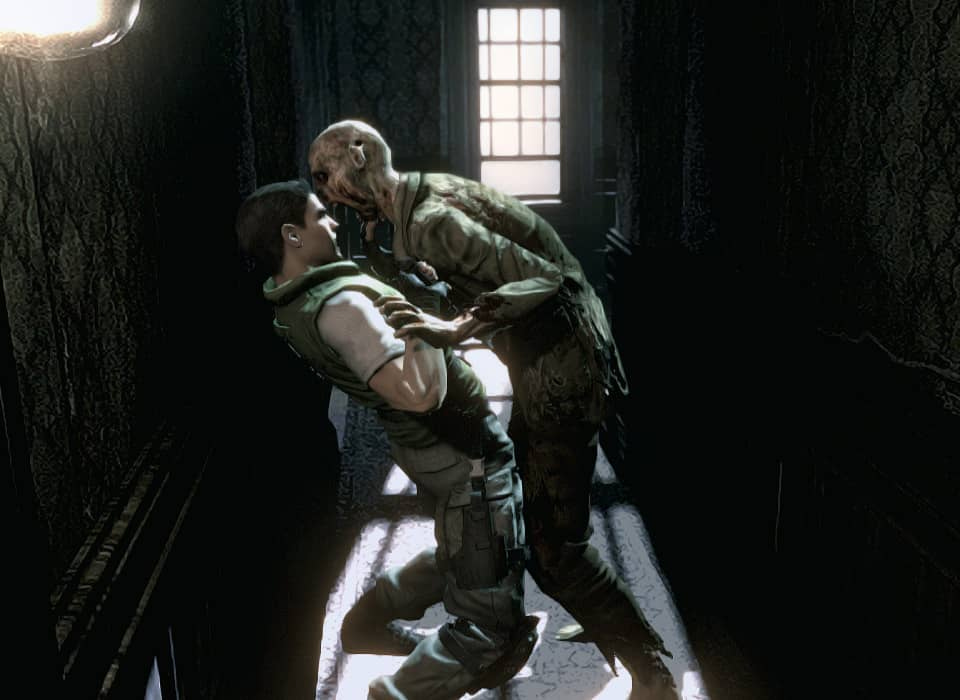Issue 4.3: Games That Go "Bump" in the Night, Part 1
A Brief & Horrifying History of Horror Games [Part of Game & Word's First Spooooktacular Halloween Special!)
Game & Word Special: Halloween 2022, Part 1

Publisher: Jay Rooney
Author, Graphics, Research: Jay Rooney
Logo: Jarnest Media
Founding Members:
Le_Takas, from Luzern, Switzerland (Member since April 14, 2022)
Ela F., from San Diego, CA (Member since April 24, 2022)
Alexi F., from Chicago, IL (Member since May 13, 2022)
Elvira O., from Mexico City, Mexico (Member since May 18, 2022)
Special Thanks:
YOU, for reading this issue.
Table of Contents
Summary & Housekeeping
Feature: “A Brief & Horrifying History of Horror Games” (~24 minute read)
Food for Talk: Discussion Prompts
Further Reading
Game & Word-of-Mouth
Footnotes
Summary:
Today, we’ll take a break from our usual programming and kick off a most spooktacular Halloween special, starting with a condensed chronology of how the horror genre entered gaming and how it has evolved over time. Read on, if you daaaaare… WOOOOOOOOOH….!
Housekeeping:
Boo!
Welcome, everyone, to Part 1 of Game & Word’s First Spooooooktacular Halloween Special! From now through Halloween weekend, I’ll be dropping some great and ghoulish content for you to enjoy late at night, huddled up under your bedsheets. Mwahahahaha!
But first, I’ve got a couple of announcements:
Halloween Bonus Content!
In addition to Game & Word’s weekly newsletter, I’ll also be publishing some bonus content for paid subscribers and founding members: over a dozen reviews of currently-available horror games!
This review collection and the Halloween Special’s Finale will both drop on Friday, October 28, instead of the usually-scheduled Sunday, October 30, so you can pick a game to get spooked by just in time for the big night!
New: Gaming Glossary!
Confused by any of the gaming jargon, slang, lingo, or other “insider terminology” in this newsletter? Well, good news: Game & Word is proud to finally unveil its comprehensive and user-friendly Glossary of Gaming Terms!
I try my best to write accessibly and keep jargon, etc. to a minimum. However, sometimes it just can’t be avoided (or I miss one while editing). So instead of explaining a term every time it comes up, I’ll link to its entry in the Glossary! Yes, it’ll take you straight to the definition, no scrolling required!
You can also access the Glossary at any time by clicking its dedicated link on the homepage (underneath the “Game & Word” logotype).
And if I missed something, feel free to drop a comment, reply to this email, or let me know at gameandword@substack.com or @GameAndWord on Twiter!
Previous Issues
NOTE: Game & Word is a reader-supported publication. The two most recent issues are available to all, free of charge, until new issues are published (podcasts and videos will always remain free).
Older issues are archived and only accessible to paid subscribers. To access articles from the Game & Word archive, support my work, and keep this newsletter free and available to all, upgrade your subscription today:
Volume 1 (The Name of the Game): Issue 1 ● Issue 2 ● Issue 3 ● Issue 4
Volume 2 (Yo Ho Ho, It’s a Gamer’s Life for Me): Issue 1 ● Issue 2 ● Issue 3 ● Bonus 1 ● Issue 4 ● Issue 5 ● Issue 6 ● Issue 7 ● Bonus 2 ● Issue 8 ● Bonus 3
Volume 3 (Game Over Matter): Intro ● Issue 1 ● Issue 2 ● Issue 3 ● Podcast 1 ● Issue 4 ● Video Podcast 1 ● Bonus 1 ● Issue 5 ● Podcast 2 ● Issue 6 ● Issue 7 ● Issue 8 ● Issue 9 ● Podcast 3 ● Bonus 2
Or, you could help offset my caffeine costs by chipping in for the price of a cup of joe:
Feature: A Brief & Horrifying History of Horror Games
👾🤔🤷 CONFUSED? ➡ NEW GAMING GLOSSARY! 📚💬🧑🎓
Confused by any of the gaming jargon, slang, lingo, or other “insider terminology” on this newsletter? Just click on the term and it’ll take you to its entry on Game & Word’s comprehensive and user-friendly Glossary of Gaming Terms!
🚨🚨🚨 SPOILER ALERT 🚨🚨🚨
This post contains spoilers with varying degrees of spoilerness for Night Trap, Resident Evil, Resident Evil 2, Silent Hill, The Last Door, The Excavation of Hob’s Barrow, System Shock, Dead Space, I Have No Mouth and I Must Scream. You've been warned!
⚠️⚠️⚠️ CONTENT WARNING ⚠️⚠️⚠️
This article contains discussions of horror and everything that comes with it. If you’re easily frightened, disturbed, or upset, please proceed with caution. Portions that are particularly squicky/gruesome will be labeled, but be warned… even the warning labels themselves can be pretty heavy. Proceed with caution.
⚖️⚖️⚖️ ETHICS DISCLOSURE ⚖️⚖️⚖️
This article contains affiliate links. If you click on any such link and purchase the linked product, Game & Word gets a small cut of the sale. This helps keep the newsletter sustainable without needing to put up paywalls or ads.
💡💡💡 POINT OF CLARIFICATION 💡💡💡
Please note this article’s title: “A Brief History of Horror Games.” As in, NOT “A Complete History of Horror Games.” This article surveys just a small fraction of the many, many, MANY games that constitute the horror gaming canon. Covering (or even mentioning) every single one would take an entire book, nevermind one issue in one humble newsletter.
So if you’re annoyed I left a game out, it wasn’t intentional. I either missed it, or had my reasons for not including it. If you’d like me to comment on a particular game, though, feel free to drop me a comment or DM letting me know. No promises, but I’ll consider your request.
On a similar note: the categories and subgenres I list here are fluid, and there’s a significant amount of overlap between them. So if you believe I should’ve put Game X into Category Y instead of Category Z, I’ve most likely thought about that already. But you’re probably right. We’re both probably right. At the end of the day, this is just one guy’s opinion.
So, let’s not get hung up on split hairs. Instead, let’s just have fun geeking out over this hobby we all love.
BOO!
It’s mid-October, which means Halloween is just around the corner! This mysterious, mystical, and monstrous season has captivated the souls of millions worldwide. And why wouldn’t it? Halloween provides a socially-sanctioned and (reasonably) safe environment where indulging our deepest fears and most forbidden desires is not only allowed, but the whole point.
Monsters, magic, mayhem… all are fair game in this most liminal of nights. Whether it’s werewolves or sexy werewolf costumes, this holiday is transgression made manifest and unleashed into the world, if only until sunrise. The Trickster, the Wizard, and the Artist rise up to seize their evening in the spotlight. Halloween is truly one of Western culture’s sacred cultural gems.
And our media reflects this. For Halloween, and the weeks leading up to it, are the perfect time to immerse yourself in the horror genre.
What Makes Horror Horrifying?
Horror is a genre (well, more like the genre) in fiction that aims1 to evoke fear in the audience. This is the through line that connects the seemingly disparate works in this unfathomably broad genre, from classics like Dracula and Frankenstein through the cheesiest 80s slasher flicks all the way to the comparatively more mundane (but no less frightening) psychological horror that’s currently in vogue.2 And you can find horror works in every mass medium, from literature, film, and TV to music, comics, podcasts, and... yes, video games.
As I’ve mentioned countless times by this point, video games hold a serious intrinsic advantage for eliciting emotion—interactivity—that other media don’t have. The interactive element immerses the player into the story and, thanks to the magic of mirror neurons, makes her feel everything on a deep and almost primal level, as if she were actually experiencing the story as well as every emotion as the character she’s playing.
Fear is no exception.
Indeed, video games have given the world some of the most viscerally frightening and disturbing experiences in the horror genre, across all media. Obviously, this isn’t everyone’s cup of tea—but if you’re a horror fan (or simply brave and open-minded enough), it just doesn’t get much better than gaming!
But alas, horror video games, like their visual counterparts in film and TV, don’t age very well. Even accounting for other factors like outdated technology, horror games often age worse, and more quickly, than works from other genres.
After all, horror holds a mirror up to society’s deepest, darkest fears—so what we collectively find scary will ebb and flow with time. On top of this, the game industry’s proclivity for milking trendy tropes, genres, and conventions until they’re bone dry (particularly in the AAA space) accelerates the aging process. Then on top of that, add the comparatively longer production cycles for video games (compared to movies or novels), and the result is a much smaller horror canon than in other media… but also one that leaves a bigger imprint on those courageous players who dive into them.
It also makes it easier to assemble a chronology3 of horror video games—chart the trends, and you’ve charted the history. So, let’s go ahead and do that right now.
Sweet dreams!
In the (Blood-Curdling) Beginning…

3D Monster Maze, the very first horror video game, landed on the Sinclair ZX-81 personal computer in 1981. It has a deceptively simple conceit: you’re in a maze, and the game scores you on the number of steps you take. But there’s also a T-Rex in the maze, and it’s hungry for a snack. So the longer you avoid becoming dino dinner, the higher your score.
It’s easy for younger gamers to look at screenshots from this game as quaint, primitive, and (most critically for a horror work) not scary. It’s a bunch of blocky pixels, and it doesn’t even have color or sound, how could it possibly be scary?! It looks so not scary at all! And if you’re a horror work, the one thing you don’t want to be is not scary.
Audiences are surprisingly forgiving with horror works—they’re willing to suspend their disbelief more than in most other genres,4 and will put up with all the cheese and camp in the world,5 as long as they feel scared. That’s the whole point of engaging in horror stories to begin with. If you’re not scared, what’s the point?
But here’s the (not really) secret that every horror virtuoso knows: often, simplicity makes a work scarier than overloading the viewer with gore and other schlock. In the absence of information, our imaginations fill in the blanks—and nothing could possibly be portrayed on celluloid or with pixels that’d be even remotely as scary as what the deepest, darkest corners of our fetid imaginations can conjure up in half a second.
Alfred Hitchcock, the master of suspense, understood this intimately, and as a result, his some of his simplest works, including Rear Window, Rope, and Lifeboat are just as gripping and finger-gnawing today as they were when they first released.
Likewise, George Romero used the same principle when he made Night of the Living Dead, which singlehandedly birthed and codified the “zombie apocalypse” subgenre, and left its indelible mark on the countless zombie movies, comics, novels, TV shows, and video games that continue to follow in its wake.
But I’m getting ahead of myself.
In any case, 3D Monster Maze’s simplicity makes it far more effective as a horror game than its simple graphics might lead you to believe. The whole game is essentially a nonstop chase sequence. A staple of horror gaming since literally the very beginning, chase sequences are among the most heart-pumping gameplay devices in the medium, and once you get into the gameplay, the graphics are almost besides the point—you’re just trying to survive.
Besides, it doesn’t hurt that the dinosaur’s design is quite uncanny and eerily off-putting. I mean, just look at that thing (pictured way above). It’s as if Smaug and Barney the Dinosaur had an abominable love child that got sucked into Tron.
Moving on through the 80s and into the 90s, horror games grew and evolved with the medium. They got color graphics, and even sound! They even got their first movie tie-ins, including that infamously godawful Friday the 13th adaptation.
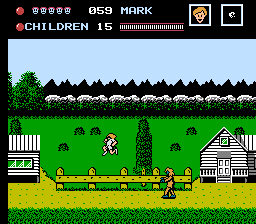
The 1989 critical and commercial bomb was indeed scary, but not because the game itself was scary, but rather by opening gamers’ eyes to just how terrible a game could be—a sobering and maddening revelation on par with any Lovecraft story. Sadly, it would not be the last terrible video game adaptation of a movie. Not even close.
Gothic horror also found a comfortable niche in gaming during this time. The most iconic example is likely the Castlevania (1986–2014) franchise of platforming games, which follows the storied Belmont clan of vampire hunters as they battle creepies and ghoulies in Dracula’s castle. Ghosts n’ Goblins (1986) was another platforming ghoulie-slasher set in a vaguely medieval world, infamous for its truly ghastly difficulty level.
In terms of gameplay, both games are more action-adventure (or just pure action) than straight-up horror. But as far as aesthetics and theme go, the horror elements are unmistakable.
But perhaps even more significantly than cheesy movie tie-ins and vampire cliches, the most consequential development for horror games in the 80s was that they latched onto their first (but by no means their last) gaming trend: point-and-click graphic adventures!
Point-and-Spook (1980s, early 1990s)
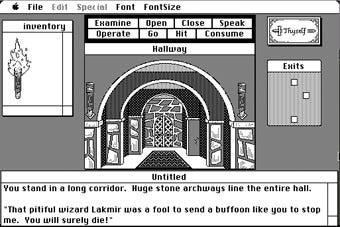
At Game & Word, we’re no strangers to graphic adventures of the point-and-click variety. We did an entire three-parter on Monkey Island (1983–), a series long held to be adventure gaming’s high-water mark, and of gaming’s most iconic franchises. And we dissected the graphic adventure genre to better understand the building blocks of narrative games.
If that’s the extent of your contact with these games, you might be forgiven for thinking that adventure games are all whimsical, light-hearted romps through anachronism blenders
But you’d be wrong. To be fair, a good chunk—and quite likely a majority—of such games are like that. Even games with themes and aesthetics usually seen in horror—like genre codifiers Maniac Mansion (1987) and its sequel Day of the Tentacle (1993)—are primarily comedic in tone.
But not all point-and-clicks are like that. Oh, no no no. Games like The Screamer (1985) and Shadowgate (1987)6 will quickly dispel you of that notion.
But the most illustrative example is Sierra’s Gabriel Knight trilogy. The games follow its titular protagonist, Gabriel Knight—a bookstore owner and paranormal investigator in New Orleans—as he uses his supernatural powers to solve mysteries.

The Gabriel Knight games are crime/mystery than straight horror, but they’re much more serious in tone than, say, Maniac Mansion, and have enough spooky elements to feel at home in the genre.
Games that go “Bump” in the Night (Trap)
These aren’t the only such examples from the 80s and 90s, never mind the many excellent point-and-click horror adventures released just over the past decade… but we’ll get to those in due time.
As technology kept marching forward, so too would video games. What would the next big trend be? For a while, it appeared that Full Motion Video (FMV) games, consisting mostly of pre-recorded video footage, would lead the charge. But after a particularly disastrous false start, coupled with the FMV craze’s novelty wearing off, such games were quickly forgotten as curious historical footnotes.
The biggest false start came in the form of a 1992 SEGA CD game called Night Trap.
Night Trap is one of those FMV games that were all the rage in the early 90s. In it, you have to save a group of teenage girls at a slumber party from being mauled by shapeshifting werewolf vampires or whatever. You did so by cycling through the surveillance footage to track the beast (or was it beasts?) and activate traps to foil its (their?) plans to turn the girls into demon chow. Mess up enough, and one of the girls becomes vampire vore.7 If you mess up enough after that, then all the girls get vampire vored, and it’s game over.
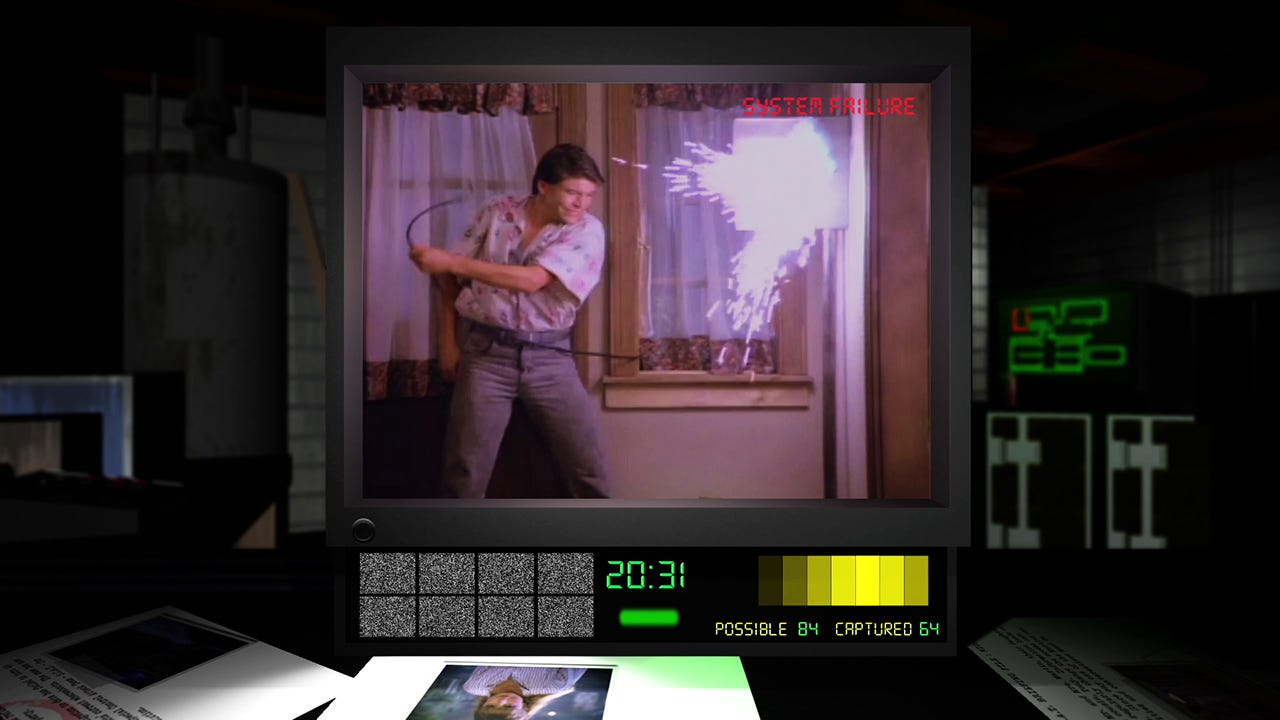
I know. From the above paragraph, it sounds really gruesome. But it really isn’t. First of all, the deaths all occur off-screen. Second, the game has a palpable B-Movie feel; it’s campy, corny, and cheesy as hell. Less Scream and more Scary Movie. Or less Halloween (1978) and more Halloween (2018). Or less Friday the 13th when it was first released, and more Friday the 13th today. You get the picture. Besides, it just wasn’t a good game.
Unfortunately, Night Trap was unbelievably unfortunate, in that it released right as one of America’s most heated moral panics on violence in video games was picking up steam.
When pearl-clutching ‘90s Karens shrieked their anti-gaming fearmongering to frightened parents and clueless legislators around the country, they cited two games as the most illustrative examples of video game violence run amok.
The first was Mortal Kombat (1992), a genuinely transgressive and almost cartoonishly gory fighting game that featured the highest-resolution pixelated blood and guts that 16-bit hardware can render.
The second was Night Trap.
Why? I have no idea. I think it was the more “realistic” FMV graphics and life-like characters, combined with the fact that these more life-like characters get murdered. They also all happen to be women, which… actually is quite questionable. Hey, I suppose a broken clock is still right twice a day.
But unlike Night Trap’s milquetoast, shlocky fare, 1992 was actually a very scary time for the game industry, as it was suddenly menaced by every capitalist’s greatest fear, something even scarier than all the grainy gore or bloodthirsty shadow vampires the 90s could conjure up:
The specter of GOVERNMENT REGULATION!!!
*thunder clap*
To appease and ameliorate the specter, the major gaming companies created the Entertainment Software Rating Board (ESRB), which assigns content ratings to games—much like the MPAA does for movies or the “Parental Warning” stickers the RIAA sticks on music albums—and pinky-promised Congress that they’d do better to police themselves and protect kids from pixelated violence.
It did the trick. Sort of. On the first front, the specter accepted the industry’s offering and retreated into the accursed Congressional halls from whence it came. While it never actually prevented kids from playing violent games, the ESRB is still doing its thing, and it does provide useful guidance for parents who actually bother to read the ratings.
However, there were some casualties. Among them: SEGA’s reign as the industry’s top dog,8 CEO Tom Kalinske’s tenure at the company, and, interestingly enough, Night Trap.
Yes, the less violent of the two pilloried games was unceremoniously pulled from stores mere months after the congressional hearings, only to be edited (read: sanitized) and re-released as a complete commercial bomb.
Meanwhile, Mortal Kombat 11 was released in 2019, and sold 12 million copies through the end of 2021.
Make of that what you will.
Anyway, in the midst of all that hysteria, a developer lit the path to horror gaming’s future, under everybody’s noses. The key was to give players complete freedom of movement in a seamless 3D environment (and scare the bejeebus out of them); this would mark horror gaming’s most pivotal moment since the genre’s inception.
That developer was Infogrames, and that pivotal moment was 1992’s Alone in the Dark.
The Survival Horror Era (1990s to late-2000s)
“YVONNE: How are you doing?
SHAUN: Surviving.”
~Shaun of the Dead (2004)
It’s hard to overstate how influential Alone in the Dark was to horror games. It was to gaming as Nosferatu was to movies, in that they both blazed the trail for countless successors up to the present day.
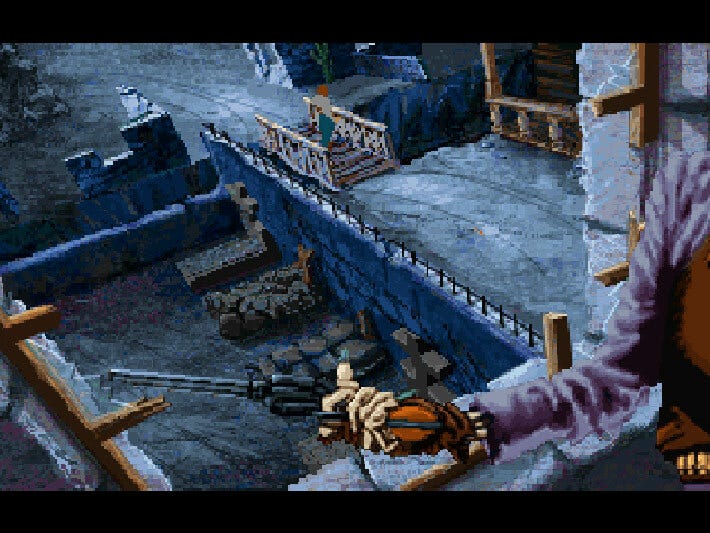
Alone in the Dark singlehandedly birthed the survival horror genre, which would become horror gamers’ preferred flavor of scary for the better part of two decades. The name comes from the genre’s empasis on survival as the player’s primary objective, a sharp departure from most games (especially at the time), which mainly set conquest or victory as the player objective.
In games from this subgenre, the player is put at such a disadvantage against her enemies that merely surviving until the end is an accomplishment in and of itself. Other genre tropes and conventions help ratchet up the tension and fear, making survival horror games genuinely thrilling emotional rollercoasters (of DOOM!) to ride. These include:
Isolating the player character in a remote or otherwise inaccessible location, such that she can’t escape or call for backup;
Putting the player at a ridiculous strength and numerical disadvantage—they are way more of them,9 only one of you, and they pack a really heavy punch;
Adding to the above: severely limiting weapons, ammo, health packs, and upgrades, which limits the player’s ability to fight back. Unlike the unlimited ammo in FPS shoot fests, every bullet counts in survival horror, so players will end up fleeing most enemies instead of fighting them;
Oh, and to top all that off: conjuring up an invincible monster to roam around the game world, one that you cannot defeat, no matter how many bullets the player pumps into it. If the developers really want to amp up the fear factor, they’ll make this monster super fast, give it super strong attacks, make it invisible/undetectable, have it actively hunt or stalk the player, or some combination of the above;
Inflicting significant and painful in-game repercussions for dying/failing. These include being really stingy with checkpoints,10 inflicting penalties before respawning, or even (in the most extreme cases) implementing permadeath;
When combined with the above, just to twist the knife in: adding urgency and pressure by having the player find the antidote to the toxin that just mortally poisoned her; rescue her partner from becoming monster mash, escape the setting before it self-destructs/gets bombed; or carry out some other time-sensitive task. Oh, and giving her an absurdly short amount of time to do so;
Liberal use of staple horror tropes and tactics perfected by filmmakers and showrunners for decades, such as jump scares, scary-looking silhouettes of furniture,11 fright chords, suspense, ominous and dissonant background music, unsettling sound effects (or the complete lack thereof), and a practically limitless supply of creepy imagery and atmospheric effects at their disposal.
Sure enough, Alone in the Dark traps you in a zombie-infested house and tasks you with escaping without becoming baddie brunch. It checks off most (but not quite all) of the above checklist, most importantly the parts about resource scarcity and choosing your battles. It also introduced other, not-so-spooky tropes that became survival horror staples, like puzzle-solving sequences and the quite-progressive-for-its-time option to pick a female or male protagonist.
Horror games would never be the same again. The zombie apocalypse had finally reached gaming. For almost two decades, survival horror (particularly zombie survival horror) would become the dominant force in horror gaming.
But at this point, this dominance still wasn’t a given. No, that’d come when another game took take what Alone in the Dark pioneered, refined it to perfection, unleashed it like a zombie horde onto players everywhere, and staked its claim to the genre.
That game was mega-publisher Capcom’s survival horror classic, Resident Evil (1996).
Games of the Dead
“Itchy. Tasty.”
~Keeper’s Diary; Resident Evil
Resident Evil took the formula that Alone in the Dark introduced and gave it a big, fat shot of steroids the T-Virus.12 It took everything on the checklist above and cranked it up until the amp blew out.
Between the visceral, terrifying gameplay, realistic (for its time) PlayStation graphics, voice-acted dialogue, and steady progression from a standard "zombie house" story to something deeper, more intriguing, and more "sci-fi"-ish,13 it blew the socks off of the legions of gamers who played it (myself included).
In Resident Evil, you play as one of two members of an elite, SWAT-like police unit investigating reports of… weird stuff going on in a secluded mansion in the woods. On the way, they’re beset by a pack of ravenous zombie dogs and are forced to shelter in the mansion. While investigating the mansion and fending off the living dead, they unearth a sinister conspiracy by a nefarious biotech company operating a secret lab underneath the mansion, where the outbreak began.
Yes, it sounds quite pedestrian for a horror work. And the whole underground lab shtick was stretching it even then—now, it’s hard to look back on it as anything but a B-Movie-level cringe. As I said, these games don’t age well.
But at the time, all that didn’t even matter—we were all too busy getting scared out of our wits to care. To this day, just saying the words “dog” and “window” within earshot of a Resident Evil veteran is enough to give the hairs on his back a residual jump scare. Behold:
[CW: Blood, violence, animal death, jump scare]
But Capcom was just getting started. Resident Evil was such a critical and commercial hit that a sequel was all but inevitable. So they followed it up with Resident Evil 2, which takes place right after the first game’s events, as the T-Virus tears through the mansion’s neighboring city. To continue the movie analogy: if Resident Evil was Night of the Living Dead, then Resident Evil 2 was Dawn of the Dead. Not just thematically, but influentially as well.
Horror gamers venerate Resident Evil 2 as much as (if not more than) its predecessor. Now that the dice were cast, and the fates turned up two smash hits bearing the Resident Evil name, there was no more denying destiny: this was something big. And lo, a franchise was born.
As of press time in 2022, there are 28 Resident Evil games and counting. The most recent one, Resident Evil: Village, dropped in 2021. The series’ quality has… fluctuated since the Resident Evil 1 + 2 double whammy, and survival horror has long faded from the mainstream and into niche genre status. But Capcom’s track record is surprisingly good, certainly much better than you’d expect for such a long-running horror franchise in any medium (not that the bar’s even remotely high, but still).
But like any trend, it was only a matter of time until survivor horror became oversaturated with imitators and hangers-on, of widely varying quality. And once that happened, it was only a matter of time before gamers lost interest and moved on to newer, shinier scarier things.
Fortunately, one of these survival horror latecomers also planted the seed for horror gaming’s next trend. Which game was it?
The game was none other than Konami’s Silent Hill (1999), still one of the scariest games ever published.
The Hills Have Games: Silent Hill and the Shift to Psychological Horror (Late 90s to late ‘00s)
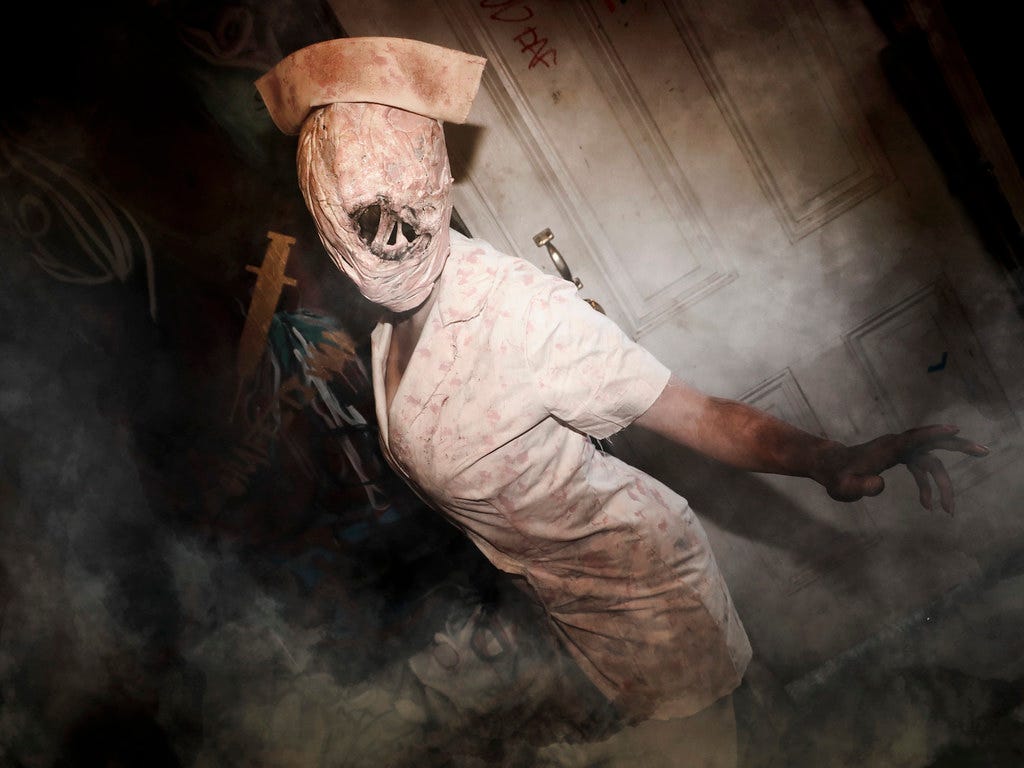
“The Only Me Is Me. Are You Sure The Only You Is You?”
~Silent Hill P.T.
While Silent Hill faithfully followed most of survival horror’s conventions, it subverted them in a few key ways. First, it didn’t have zombies as its main monsters. They’re easy to mistake for zombies at first glance. But they’re not zombies. They’re… something else. Something more… otherworldly. Something more… ghastly… infernal… eldritch, perhaps?
Second, and related to the first point, the setting hasn’t been overrun by ghouls. At least not at first. In fact, it’s completely deserted and blanketed in a suffocating fog. Well, unless the church bells ring and the world transforms into a nightmarish world of rain, darkness, rust, blood, and demons.
Or… does it?
Third, and most importantly, the entire game takes place in your head. Kind of. Maybe. The game has multiple endings, depending on how well you played, and Konami’s pretty ambiguous on which one is canon.
But said canon (which was fleshed out some more in the game’s many sequels) has confirmed this: troubled people are drawn to Silent Hill like moths to a flame. It’s a supernatural hot spot where these people’s deepest, darkest fears and regrets come to life.
So in addition to confronting hellish nightmarescapes and equally hellish eldritch monstrosities, the protagonist also confronts their own internal monstrosities—their traumas, regrets, fears, and insecurities. Which is arguably even scarier.

This was the game’s genius: being a mostly paint-by-numbers survival horror game… while adding a big ole’ triple-scoop of psychological horror to top it off.
Survival horror would soon fade from the limelight.14 But the Silent Hill games (which, unlike Resident Evil, steadily and consistently declined in quality with each new entry) nevertheless planted a seed. And gamers found themselves with an appetite for more. Soon, horror games would turn away from the horrors around us… and turn their gaze towards the horrors within us.
And this… is where it get really interesting.
Stay Tuned!
Thank you for reading! Next time, we’ll learn about the heyday of psychological horror, and look at how horror gaming—propelled by the indie scene—both ventured out into new subgenres and brought back some old favorites. Finally, we’ll examine where horror gaming’s at today and where it could go, laying the foundation for Game & Word’s ultra-spooktacular Halloween Weekend Issue!
I’ll see you then. Stay safe, and remember—don’t go in the woods!
Cheers,
~Jay
Food for Talk: Discussion Prompts
While you wait for the next issue, I invite you to mull over the following discussion prompts. Please reply to this email with your answers, or post them in the comments—I'd love to hear your thoughts!
Do you like scary stories? Why, or why not? Which is your favorite, and what do you like about it?
If you’re into horror, which subgenres do you enjoy most? What draws you to them?
What is your deepest, darkest fear?
Which do you enjoy most, Halloween’s spooky side or its fun side? And how so?
Further Reading
NOTE: The following list may contain affiliate links, which give me a tiny cut of any purchases made through the link. this helps keep the newsletter sustainable.
Itchy, Tasty by Alex Aniel — The behind-the-scenes story of how Resident Evil came to be and changed horror gaming forever.
Console Wars by Blake J. Harris — A great read for anyone interested in gaming history in general. But most pertinently to the topic, it also chronicles the Night Trap fiasco that shook the industry to its core.
Games Featured:
NOTE: The following list may contain affiliate links, which give me a tiny cut of any purchases made through the link. this helps keep the newsletter sustainable.
Night Trap, developed by Screaming Villains, published by
SEGAScreaming Villains — Steam | Nintendo Switch [Digital] | Nintendo Switch [Physical] | PlayStation 4 [Digital]Shadowgate, developed and published by Abstraction Games — Steam | Nintendo Switch [Digital] | Nintendo Switch [Physical] | PlayStation 4 [Physical] | Xbox One [Digital]
Gabriel Knight: Sins of the Fathers, developed and published by Sierra — Steam | GOG | iOS | Android
Alone in the Dark, developed by Infogrames/Pieces Interactive, published by THQ Nordic — Steam | GOG | Xbox | PlayStation 5 [Remastered Edition; Pre-Order]
Resident Evil: Origins Collection, developed and published by CAPCOM — Xbox One [Physical] | PlayStation 4 [Physical] | Nintendo Switch [Physical] |
Game & Word-of-Mouth: How to Support My Work
Thank you for reading! If you enjoyed this content and would like to read more of it, there are many ways you can show your support for Game & Word. First, hit the heart button at the bottom of the post—it really helps with my discoverability! You can also show your support by sharing this issue with your social networks and subscribing to Game & Word (if you haven't already).
Finally, if you haven’t upgraded to a paid subscription, well, that’s the best way to support this publication. You can upgrade your subscription using the following button, or in your account settings (note that you can only upgrade your subscription on the web, not through the app):
See you next week!
Tags
#history #horror #halloween
#TempusLudos
#3DMonsterMaze #GabrielKnight #NightTrap #Castlevania #AloneInTheDark #ResidentEvil #SilentHill
Footnotes
Now, whether a given work succeeds is another question entirely—with almost as many answers as there are subgenres in this impressively broad genre.
Though arguably past its peak and slowly on its way to cult/niche status.
Hey, looks like this special’s still somewhat related to our theme-du-jour!
Don’t believe me? 21 years and eight sequels after Friday the 13th forever made hockey masks a staple of Halloween costume stores, they sent Jason Voorhees into goddamned SPACE, and some fans still ate it up!
Shadowgate is arguably more fantasy than straight horror, but it sure creeped me out as a kid!
If you value your soul, your sanity, or even just your supper, do not… I repeat, in the name of all that’s holy, DO NOT look that word up!
Followed by SEGA’s long, slow, and terminal decline from console manufacturer and industry powerhouse to third-tier publisher and cautionary tale about obstinacy, mismanagement, and lack of vision.
This is partly why zombies are overwhelmingly the subgenre’s monster of choice: as zombies by definition attack in hordes, they’re an easy way to sic an endless amount of humanoid adversaries on the player and/or give the player infinite cannon fodder, all while avoiding the extra layer of ickiness from killing live human beings (especially in such big numbers).
Checkpoints allow players who’ve “died” to restart from the last checkpoint they activated, instead of from the very beginning. Survival horror games love to limit the number of checkpoints in the game and place them far in between each other.
So getting mauled by a zombie in a survival horror game denotes a much bigger loss of progress and time invested than in a game that distributes checkpoints more generously. Because it’ll take that much longer to get back to where you were before the zombie snacked on your brains.
Or other things that are ultimately harmless, but still scary as hell until you turn on the lights.
In Resident Evil, the T-Virus is the manufactured pathogen responsible for the zombie outbreak.
Looking back, a little far-fetched and borderline hokey. But at the time, way cool!
Although some contemporary survival horror games, like the singularly terrifying Dead Space series, have continued carrying the torch.








